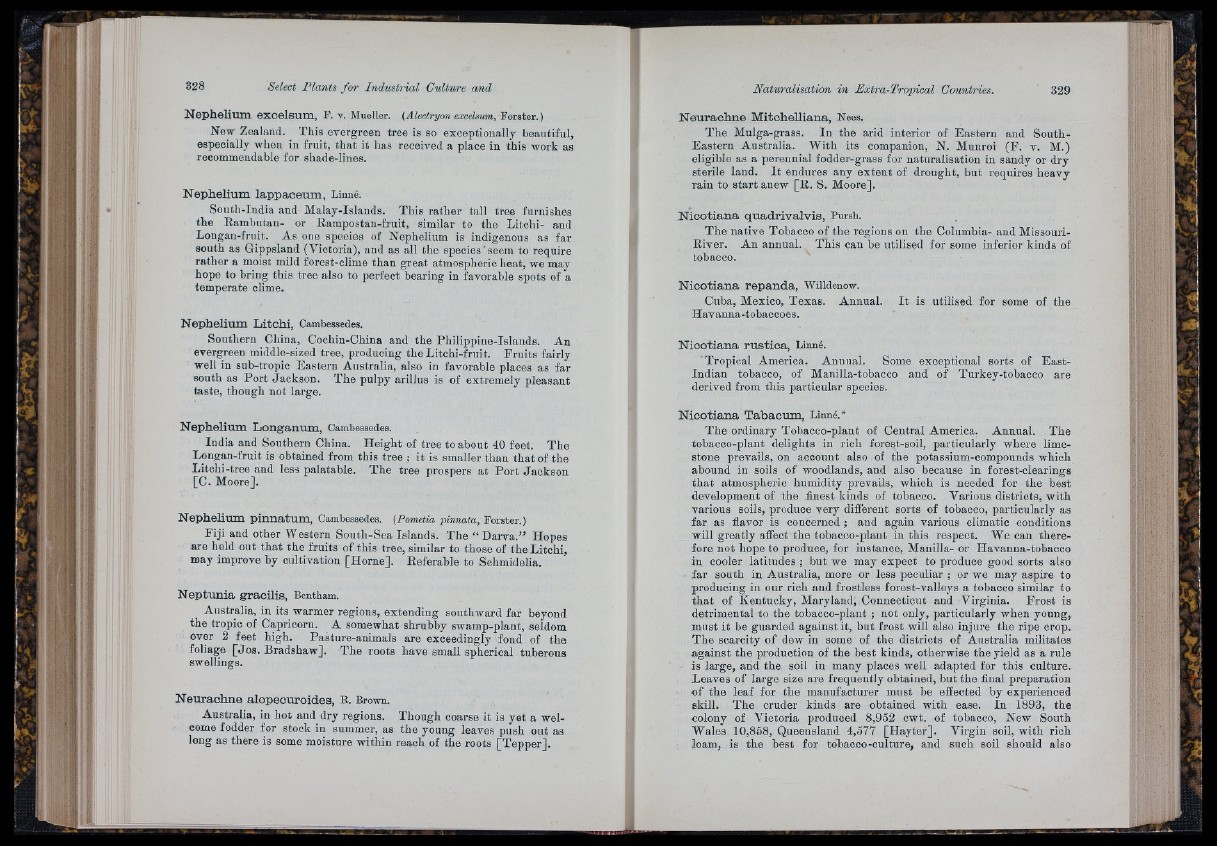
f l
¡: ,i'Ÿ
l'i
f
, í
í f : ' ‘
ïfrifr
I -i
■': - i ! I,
Nephelium excelsum, P. v. Mueller. (Alectryon excelsum, Forster.)
New Zealand. This evergreen tree is so exceptionally beautiful,
especially when in fruit, th a t it has received a place in this work as
reeommendable for shade-lines.
Nephelium lappaceum, Linné.
Sonth-India and Malay-Islands. This rather tall tree furnishes
the Rambntan- or Rarapostan-fruit, similar to the Litohi- and
Longan-frnit. As one species of Nephelium is indigenous as far
south as Gippsland (Victoria), and as all the species' seem to require
rather a moist mild forest-clime than great atmospheric heat, we may
hope to bring this tree also to perfect bearing in favorable spots of a
temperate clime.
Nephelium Litchi, Cambessedes.
Southern China, Cochin-China and the Philippine-Islands. An
evergreen middle-sized tree, producing the Litchi-fruit. Fruits fairly
well iu sub-tropic Eastern Australia, also in favorable places as far
south as Port Jackson. The pulpy arillus is of extremely pleasant
taste, though not large.
Nephelium Longanum, Cambessedes.
India and Southern China. Height of tree to about 40 feet. The
Longan-frnit is obtained from this tree ; it is smaller than th a t of the
Litehi-tree and less palatable. The tree prospers at P o rt Jackson
[C. Moore],
Nephehum pinnatum, Cambessedes. [PoTnxtia pinnata, Forster.)
Fiji and other Western South-Sea Islands. The “ Darva.” Hopes
are held out th a t the fruits of this tree, similar to those of the Litohi,
may improve by cultivation [Horne]. Referable to Sohmidelia.
Neptunia gracilis, Bentham.
Australia, in its warmer regions, extending southward far beyond
the tropic of Capricorn. A somewhat shrubby swamp-plant, seldom
over 2 feet high. Pasture-animals are exceedingly fond of the
foliage [Jos. Bradshaw]. The roots have small spherical tuberous
swellings.
Neurachne alopecuroid.es, R. Brown.
Australia, in hot and dry regions. Though coarse it is yet a welcome
fodder for stock in summer, as the young leaves push out as
long as there is some moisture within reach of the roots [Tepper].
\
Neurachne Mitchelliana, Nees.
The Mulga-grass. In the arid interior of Eastern and South-
Eastern Australia. With its companion, N. Munroi (F. v. M.)
eligible as a perennial fodder-grass for naturalisation iu sandy or dry
sterile laud. I t endures any extent of drought, but requires heavy
rain to start anew [R. S. Moore].
Nicotiana quadrivalvis, Pursh.
The native Tobacco of the regions on the Columbia- and Missouri-
Eiver. An annual. This can be utilised for some inferior kinds of
tobacco.
Nicotiana repanda, Willdenow.
Cuba, Mexico, Texas. Annual.
Havanna-tobaccoes.
I t is utilised for some of the
Nicotiana rustica, Linné.
Tropical America. Annnal. Some exceptional sorts of East-
Indian tobacco, of Manilla-tobacco and of Turkey-tobacco are
derived from this particular species.
Nicotiana Tabacum, Linné.*
The ordinary Tobaoco-plant of Central America. Annual. The
tobacco-plant delights in rich forest-soil, particularly where limestone
prevails, on account also of the potassium-compounds which
abound in soils of woodlands, and also because in forest-clearings
th a t atmospheric humidity prevails, which is needed for the best
development of the finest kinds of tobacco. Various districts, with
various soils, produce very different sorts of tobacco, particularly as
far as flavor is concerned ; and again various climatic conditions
will greatly affect the tobacco-plant in this respect. We can therefore
not hope to produce, for instance, Manilla- or Havanna-tobacoo
in cooler latitudes ; hut we may expect to produce good sorts also
far south in Australia, more or less peculiar ; or we may aspire to
producing in our rich and frostless forest-valleys a tobacco similar to
th a t of Kentucky, Maryland, Connecticut aud Virginia. Frost is
detrimental to the tobacco-plant ; not only, particularly when young,
must it be guarded against it, but frost will also injure the ripe crop.
The scarcity of dew iu some of the districts of Australia militates
against the production of the best kinds, otherwise the yield as a rule
is large, and the soil iu many places well adapted for this culture.
Leaves of large size are frequently obtained, but the final preparation
•of the leaf for the manufacturer must be effected by experienced
skill. The cruder kinds are obtained with ease. In 1893, the
colony of Victoria produced 8,9o2 cwt. of tobacco. New South
Wales 10,858, Queensland 4,577 [Hayter]. Virgin soil, with rich
loam, is the best for tobacco-culture, and such soil should also